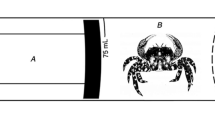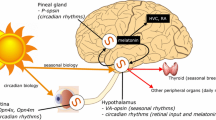Summary
In higher organisms, many physiological and behavioral functions exhibit daily variations, generated by endogenous circadian oscillators. It is not yet clear whether all the various rhythms that occur within an individual depend on one and the same pacemaker or whether different pacemakers are involved. To examine this question, the feeding and perch-hopping rhythms were measured in European starlings (Sturnus vulgaris) under light-dark cycles and continuous dim light. In dim light, the internal phase relationship between the feeding and perch-hopping rhythms changed systematically as a function of the circadian period, and the two rhythms could even dissociate and show different circadian periods in individuals with extremely long or extremely short circadian periods. Moreover, in some birds kept on lowamplitude light-dark cycles, the rhythm of feeding was synchronized 180° out of phase with the rhythm of locomotor activity. These results strongly suggest that in the European starling the feeding and locomotor activity rhythms are controlled by separate circadian pacemakers.
Similar content being viewed by others
References
Aschoff J (1980) Biological clocks. In: Proc 17th International Ornithol Congress, Berlin, pp 113–136
Aschoff J (ed) (1981) Handbook of behavioral neurobiology, vol 4. Biological rhythms. Plenum, New York
Aschoff J, Wever R (1976) Human circadian rhythms: a multioscillator system. Fed Proc 35:2326–2332
Aschoff J, Gerecke U, Wever R (1967) Desynchronization of human circadian rhythms. Jpn J Physiol 17:450–457
Aschoff J, Figala J, Pöppel E (1973) Circadian rhythms of locomotor activity in the golden hamster (Mesocricetus auratus) measured with two different techniques. J Comp Physiol Psychol 85:20–28
Beldhuis H, Dittami JP, Gwinner E (1988) Melatonin and the circadian rhythms of feeding and perch-hopping in the European starling, Sturnus vulgaris. J Comp Physiol A 164:7–14
Cassone VM, Menaker M (1984) Is the avian circadian system a neuroendocrine loop? J Exp Zool 232:539–549
Chabot CC, Menaker M (1992) Effects of physiological cycles of infused melatonin on circadian rhythmicity in pigeons. J Comp Physiol A 170:615–622
Daan S, Beersma DGM (1984) Circadian gating of human sleep and wakefulness. In:Moore-Ede MC, Czeisler CA (eds) Mathematical models of sleep-wake cycles. Raven Press, New York, 129–158
Daan S, Beersma DGM, Borbély AA (1984) Timing of human sleep: recovery process gated by a circadian pacemaker. Am J Physiol 246:R161–178
Ebihara S, Oshima I, Yamada H, Goto M, Sato K (1987) Circadian organization in the pigeon. In: Hiroshige T, Honma K (eds) Comparative aspects of circadian clocks. Hokkaido Univ Press, Sapporo, pp 88–94
Gänshirt G, Daan S, Gerkema MP (1984) Arrhythmic perch-hopping and rhythmic feeding of starlings in constant light: separate circadian oscillators? J Comp Physiol A 154: 669–674
Gwinner E (1989) Melatonin in the circadian system of birds: model of internal resonance. In: Hiroshige T, Honma K (eds) Circadian clocks and ecology. Hokkaido Univ Press, Sapporo, 127–145
Gwinner E, Subbaraj R, Bluhm CK, Gerkema M (1987) Differential effects of pinealectomy on circadian rhythms of feeding and perch-hopping in the European starling. J Biol Rhythms 2:109–120
Oshima I, Yamada H, Goto M, Sato K, Ebihara S (1989) Pineal and retinal melatonin is involved in the control of circadian locomotor activity and body temperature rhythms in the pigeon. J Comp Physiol A 166:217–226
Pohl H (1971) Über Beziehungen zwischen circadianen Rhythmen bei Vögeln. J Ornithol 112:266–278
Sokolove PG, Bushell WN (1978) The chi-square periodogram: its utility for analysis of circadian rhythms. J Theor Biol 17:131–160
Subbaraj R, Gwinner E (1985) Differential effects of testosterone on the circadian rhythms of locomotor activity and feeding in the European starling. Naturwissenschaften 72:663–664
Underwood H, Siopes T (1984) Circadian organization in Japanese quail. J Exp Zool 232:557–566
Yamada H, Oshima I, Sato K, Ebihara S (1988) Loss of the circadian rhythms of locomotor activity, food intake and plasma melatonin concentration induced by constant bright light in the pigeon (Columba livia). J Comp Physiol A 163: 459–463
Author information
Authors and Affiliations
Rights and permissions
About this article
Cite this article
Ebihara, S., Gwinner, E. Different circadian pacemakers control feeding and locomotor activity rhythms in European starlings. J Comp Physiol A 171, 63–67 (1992). https://doi.org/10.1007/BF00195961
Accepted:
Issue Date:
DOI: https://doi.org/10.1007/BF00195961




